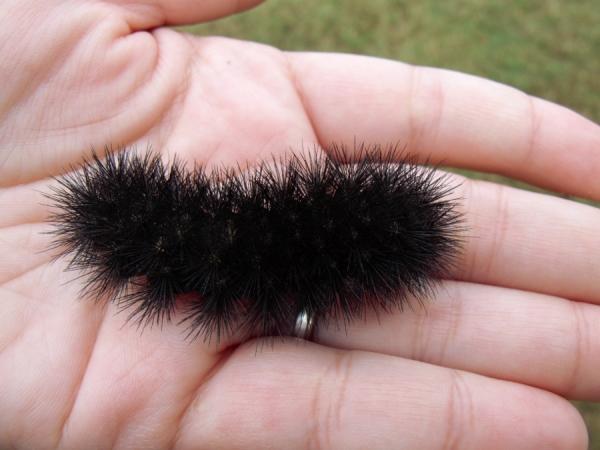
Fall is a great time to see all manner of fuzzy caterpillars! Though there are a lot fewer out at Prairie Ridge this year compared to the last few years, there are still plenty out and about on the grounds. We recently came across one of the largest of the fuzzy caterpillars, the Giant Leopard Moth.

Giant Leopard Moths are found throughout most of the eastern US and southeastern Canada. The caterpillars are easy to distinguish from other caterpillars. They start off small with orange and dark brown bands along the length of the body and are covered in stiff black hairs called setae (pronounced SEE-tee). As they grow, the banding along the body disappears. Older caterpillars are huge, close to three inches long, and black with bright red intersegmental areas (the soft, stretchy areas between the hard plates that make up the exoskeleton). The entire body is covered in a dense layer of shiny black, thick, bristly setae.
Adult Giant Leopard Moths are also large (wingspans reach 3.6 inches) and are spectacular. The thorax is bright white with black rings encircling iridescent blue spots, and the wings are bright white with black spots, either solid or hollow. The abdomen is typically covered by the wings, but is iridescent blue-black with orange markings when exposed. Overall, this is a showy species from start to finish!
The caterpillars of Giant Leopard Moths have a hugely varied diet and feed on a wide variety of herbaceous and woody plants. In North Carolina, they’re likely to feed on sunflowers, magnolias, cherries, willows, maples, dandelions, violets, and American Pokeweed, though they probably feed on many other species as well. They have a curious habit of feeding on one plant for a while and then moving to another plant, often a completely different species. However, they are not considered pests of any plant species, consuming only small amounts of many different plants.
Giant Leopard Moth caterpillars are thought to store the toxins they consume with some of their host plants, such as American Pokeweed, within their bodies as a defense against predators. This may be the reason behind the bright red markings in the larvae and the stark black, white, and orange markings of the adults. Adults are also known to excrete an acrid yellow fluid when disturbed. Unlike many other caterpillars belonging to the tiger moth family, Giant Leopard Moth caterpillars do not have stinging hairs, but they still use their hairs as a sort of defense. When disturbed, the caterpillars will curl up very tightly head to tail, hiding their soft undersides beneath their thick layer of bristles, and exposing the red markings along their bodies. Due to the way the bristles are oriented on their bodies, it is very difficult to grab a rolled up Giant Leopard Moth caterpillar to eat it. The predator ends up pushing it away instead!
Xem thêm : Bookshelf
Like several other tiger moth species, the caterpillars of the Giant Leopard Moth overwinter as mature larvae and begin to search for winter shelters in the fall. The caterpillars are usually nocturnal, but they are often spotted in the fall crossing roads in daylight as they wander in search of a place to overwinter. In the spring, they will resume feeding briefly before pupating, metamorphosing into adults before beginning to search for mates. In the south, it is possible for this species to produce two generations a year, though in the northern parts of their range they produce only one.
This is a great time of year to look for Giant Leopard Moth caterpillars at Prairie Ridge! On your next visit, keep an eye out for large black caterpillars along the dirt road to the Outdoor Classroom and on the grass to either side. The caterpillars are out looking for places to overwinter, so visit soon for your best chance to see one!
What Time is it in Nature is a weekly feature highlighting the current plants, animals, and other wildlife at the Museum’s public outdoor facility, Prairie Ridge Ecostation. Find out more about the natural happenings at Prairie Ridge at our What Time is it in Nature Archive!
(Photo by Chris Goforth)
Nguồn: https://blogtinhoc.edu.vn
Danh mục: Info









